Have you ever found yourself gazing at your hairbrush, wondering why there's more hair in there than usual? Relax, you're not the only one. Believe it or not, hair loss in women is more common than you'd think. Nope, it's not just a 'guy thing'. Together, let's unravel the enigma that is female pattern hair loss. Let's delve into this labyrinth, identifying causes and symptoms and equipping you with the knowledge you need to tackle this issue head-on. So, are you ready to plunge into the world of women's hair loss, decode its symptoms, and find ways to counteract it? Let's get down to the nitty-gritty.
Table of Contents
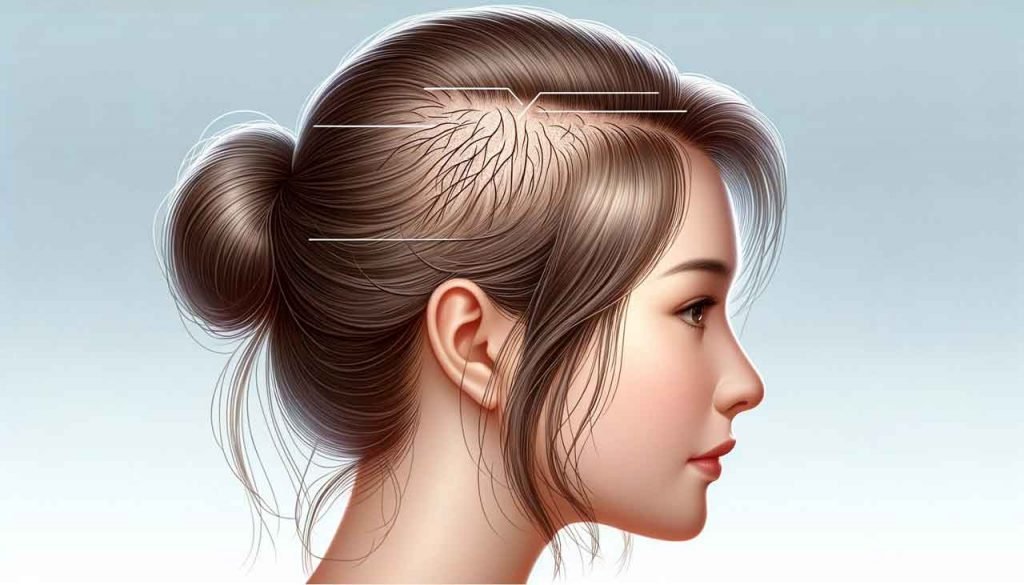
What is Hair Loss in Women, and How Common is it
You might wonder what exactly hair loss is in women and how prevalent it is. Well, it's not just a male issue; it's surprisingly common among women, too. We will discuss everything from defining hair loss in women to the role of factors like menopause and thyroid to the impact of hereditary influences.
Defining Hair Loss in Women
Experiencing an unexpected and heavy loss of hair, you're likely dealing with what's medically known as alopecia, a condition that's more common in women than you might think. Defining hair loss in women is more than just noticing a few strands in your brush or on your pillow. It's a significant hair thinning that can lead to a visible scalp or a change in your hairline. Let's break down the basics:
- Hair loss in women, also known as female pattern hair loss, can occur at any age.
- A widening part or thinner ponytail often signals it.
- The causes vary from hormonal changes to stress, with genetics also playing a role.
- Effective treatments are available, so don't suffer in silence. You're not alone in this struggle.
Statistics Behind Female Hair Loss
So, how prevalent is hair loss in women, and what are the statistics behind it? You're not alone in asking this. Female pattern baldness, or androgenetic alopecia in women, is quite common. It's estimated that millions of American women, just like you, grapple with this issue. That's right; the statistics behind female hair loss reveal that nearly 30 million American women are affected by it. And this isn't a new phenomenon, as the history of hair loss in women stretches back centuries. As you navigate this journey, remember you're part of a vast community of women who share your struggles and triumphs. You're not alone, and there are resources and solutions available to help you.
Differentiating Male Hair Loss from Female Hair Loss
Understanding the differences between men's and women's hair loss can help you better grasp your situation. It's essential to know that female pattern hair loss differs significantly from male hair loss.
- Pattern: Male hair loss usually begins at the temples or crown, while in women, it generally starts as a widening of the part.
- Progression: Men may progress to complete baldness, while women typically retain some hair, experiencing thinning rather than total loss.
- Frequency: Hair loss in women is common, affecting nearly 40% of women by age 50.
- Causes: Both genders can experience hair loss due to genetics, hormones, or age, but women may also lose hair due to pregnancy, menopause, or polycystic ovary syndrome.
The Role of Menopause and Thyroid in Women's Hair Loss
After grasping the differences between male and female hair loss, you must understand how menopause and thyroid conditions can significantly impact hair loss in women. Menopause, a natural part of aging, often triggers hormonal changes leading to hair thinning or even female pattern hair loss. Similarly, thyroid issues, both hypo and hyperthyroidism, can cause hair loss in women due to imbalances in thyroid hormones. Remember, you're not alone in this; women's hair loss is more common than you might think, especially post-menopause. By recognizing the role of menopause and thyroid health in hair loss, you're taking an important step toward understanding and managing this condition. You're part of a community, and together, we can face this challenge head-on.
Impact of Hereditary Factors on Female Hair Loss
Building on what you've learned about the role of menopause and thyroid health in women's hair loss, it's time to delve into the impact of hereditary factors. Hereditary hair loss, also known as female pattern hair loss, is a significant cause of hair loss in women.
- Hereditary Hair Loss: Your genes play a crucial role in hair loss. If your family members experience hair loss, your chances increase.
- Female Pattern Hair Loss (FPHL): This is the most common type, often due to genes and hormones.
- Impact of Hereditary Factors: These can accelerate the onset of hair loss, worsen its extent, and influence its pattern.
- Prevalence: Hereditary hair loss is common, affecting millions of women worldwide.
Understanding these factors can help you take proactive steps toward hair health.
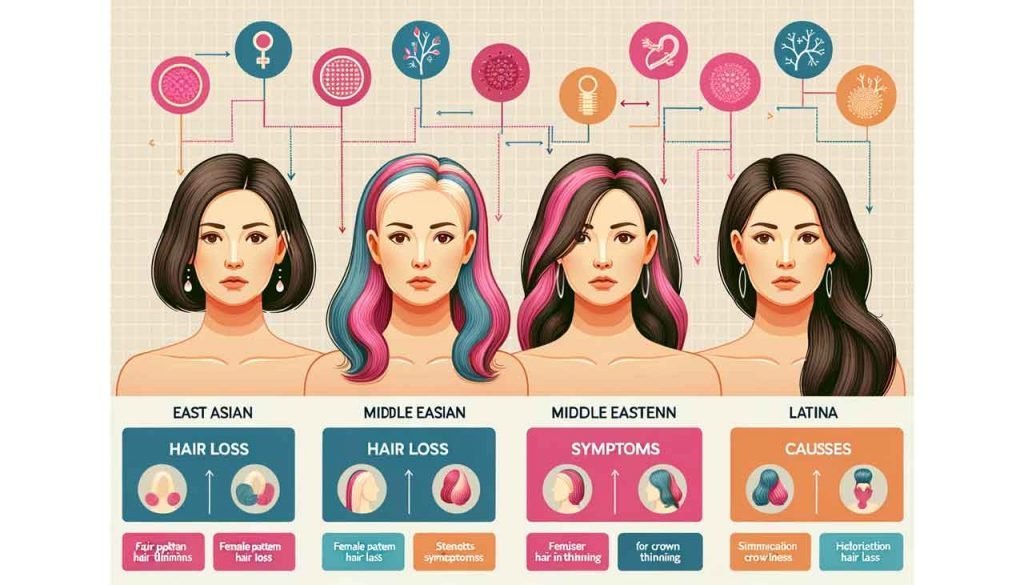
Types of Hair Loss in Women
In understanding hair loss in women, you must familiarize yourself with different types. From Female Pattern Hair Loss to Traction Alopecia and Androgenetic Alopecia, each type has unique symptoms and causes. Let's explore these types of alopecia and learn how they contribute to hair loss.
Overview of Female Pattern Hair Loss
While you may be familiar with the term 'hair loss,' it's important to understand that Female Pattern Hair Loss (FPHL) is the most common type of hair loss in women, characterized by progressive thinning over the top and sides of the head.
- Female Pattern Hair Loss (FPHL): This is a common cause of hair loss in women, resulting in hair thinning primarily on the top and sides of the scalp.
- Causes: While the exact cause is unknown, genetics, aging, and hormonal changes play a significant role.
- Symptoms: The most obvious symptom is hair thinning. However, unlike in men, the hairline usually remains unchanged.
- Treatment: Treating female pattern hair loss can involve various methods, including topical treatments, medication, and, in severe cases, hair transplant surgery.
What is Traction Alopecia
You've probably heard of Female Pattern Hair Loss, but did you know there's another type of hair loss called Traction Alopecia? Traction Alopecia is a type of hair loss that happens when the hair is pulled too tightly for a long time, causing stress on the hair follicle. This can cause hair loss, particularly in those who frequently wear tight hairstyles, such as braids or ponytails. It's essential to understand this, as you can make changes to prevent it. If you think you're suffering from this type of hair loss, there's no need to panic. There are treatment options for hair loss, including changes in hairstyle, certain medications, or even hair transplant surgery. Remember, you're not alone, and help is available.
The Role of Androgenetic Alopecia in Hair Loss
Despite traction alopecia being a major concern, a significant number of women also suffer from androgenetic alopecia, commonly referred to as Female Pattern Hair Loss (FPHL). This type of hair loss in women is more than just an aesthetic issue; it's a sign of an underlying health condition that deserves attention.
Understanding the role of androgenetic alopecia in hair loss can help you take control of your hair health. Here's what you need to know:
- Androgenetic alopecia is an inherited condition that can start as early as your 20s.
- It typically leads to hair thinning, predominantly on the top and front of the scalp.
- The causes of FPHL are complex, often involving genetics, hormonal changes, and aging.
- Key symptoms include hair thinning and increased hair fall.
Exploring Alopecia Areata as A Cause of Hair Loss
Let's delve into Alopecia Areata, another significant type of hair loss you might encounter. This condition, a common cause of hair loss in women, is characterized by sudden, patchy hair loss. It's like your hair has joined a secret club, and they're holding meetings on your scalp. But don't worry; you're not alone in this journey. Exploring Alopecia Areata helps us understand its impact and how we can address it. It often begins with one or more round, smooth patches of hair loss and can occasionally lead to complete hair loss. Remember, every woman's experience is unique, and there's a community ready to support and share in your experiences. Understanding Alopecia Areata is a vital step in reclaiming control over your hair and your confidence.
Delving into Symptoms and Causes of Various Types of Alopecia
Understanding the symptoms and causes of various types of alopecia is crucial in your journey to manage hair loss effectively. You're not alone in this, and knowing what you're dealing with is the first step towards finding a solution.
- Alopecia Areata: This type of alopecia causes patches of baldness and is often linked to stress or an overactive immune system.
- Telogen Effluvium: This is temporary hair loss, usually following a shock or traumatic event.
- Anagen Effluvium: Typically caused by chemotherapy, this type of alopecia results in extensive hair loss.
- Female Pattern Hair Loss: The most common type of hair loss in women, this is characterized by thinning hair on the top and front of the head.
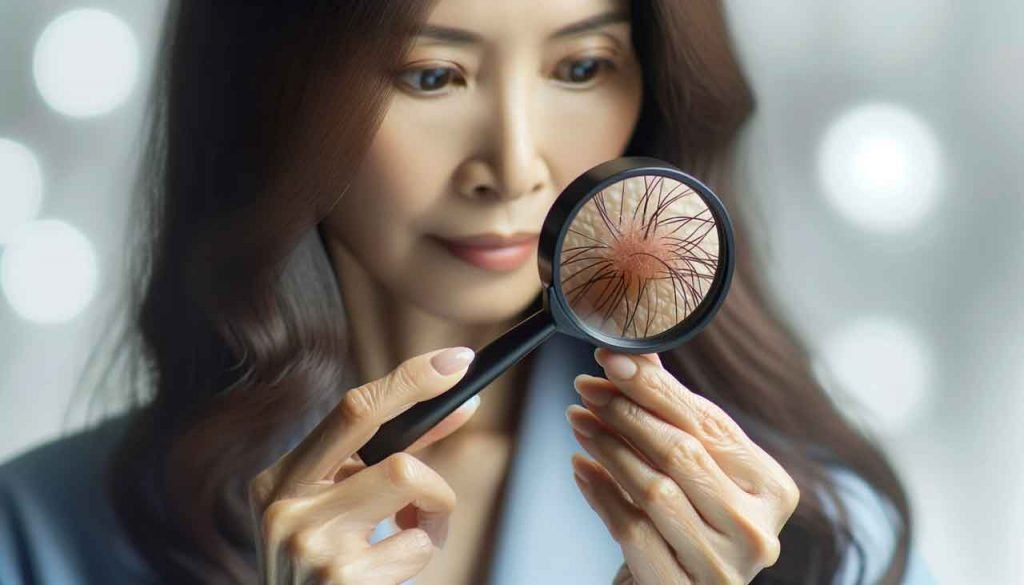
Why Does Hair Thin and Fall Out in Women
You might wonder why hair tends to thin and fall out, especially in women. It's not just about age but also the complex interplay of hair growth cycles, scientific processes, and various external factors. So, let's get started and shed some light on these causes, how they lead to hair loss, and the pathophysiology behind this common issue.
Understanding Hair Follicles and Hair Growth
In the context of hair loss, you must comprehend the intricacies of hair follicles and the hair growth process. Understanding hair follicles and hair growth allows you better to navigate the journey of hair thinning and loss.
- Hair Growth Cycle: Your hair grows in cycles - a growth phase, resting phase, and shedding phase. However, when hair follicles shrink, the new hair is thinner and shorter.
- Healthy Follicles: Healthy follicles stimulate hair growth, forming strong, thick strands.
- Dying Follicles: When follicles die or shrink, they cannot produce new hair, causing thinning or bald spots.
- Stimulation: Certain treatments can stimulate hair growth by reviving shrunken follicles.
Scientific Explanation for Hair Thinning and Losing Hair
Let's explore the science behind your hair's thinning and falling out. Female pattern hair loss is a common cause of hair thinning and loss in women. Essentially, it's an imbalance between hair growth and shedding, with more hairs falling out than growing in. Genetics often play a role, and symptoms can start as early as your teenage years. Hormonal changes, particularly those related to menopause, can also trigger hair loss. Additionally, certain illnesses or medications can cause temporary or permanent hair loss. It's essential to seek professional help if you're losing hair, as the causes
vary widely. Remember, you're not alone in this – many women experience hair loss, and there's a community here to support you.
The Relationship Between Hair Fall and Hair Changes with Age
As you age, many changes occur in your body, and your hair isn't exempted from this process, often leading to thinning and hair fall. These age-related hair changes can be confusing and distressing, but they're a natural part of growing older.
- Decreased Hair Growth: Over time, each strand of hair spends more time in the resting phase and less time growing, leading to thinner hair and slower growth.
- Reduced Hair Density: With age, the number of follicles producing hair gradually diminishes, resulting in noticeable hair loss.
- Hormone Changes: Hormonal shifts, especially during menopause, can cause hair to become thinner and fall out.
- Nutrient Deficiency: Aging may affect nutrient absorption, impacting hair health and growth.
You're not alone in this journey, and understanding these changes can help you cope better.
How Do Common Causes Lead to Hair Loss
Understanding why your hair is thinning and falling out requires knowing the common causes that lead to hair loss in women. The most common cause is female pattern hair loss, a genetic condition that leads to thinning hair. Other causes include hormonal changes, stress, and certain medical conditions.
| Common Cause | How it Leads to Hair Loss |
|---|---|
| Female Pattern Hair Loss | Genetics cause hair follicles to shrink, leading to thinner hair |
| Hormonal Changes | Changes in estrogen and progesterone can cause hair to thin |
| Stress | High-stress levels can cause hair to go into a resting phase, resulting in hair loss. |
| Medical Conditions | Conditions like thyroid disease and anemia can lead to hair loss |
Recognizing these symptoms and causes can help you take action against hair loss.
Understanding the Pathophysiology of Hair Falls in Women
While you might be aware that hair loss in women can be quite common, it's crucial to delve into why your hair is thinning and falling out. Understanding the pathophysiology of hair falls gives us insight into the root causes. Here are four key factors:
- Hormonal Changes: Hormonal imbalances often trigger hair loss in women, especially during menopause or post-pregnancy.
- Genetics: Female pattern hair loss can be inherited. If your family has a history of thinning hair, you might be more susceptible.
- Stress and Illness: Both physical and emotional stress can lead to temporary hair loss.
- Nutritional Deficiencies: Lack of certain nutrients, like iron or protein, can cause hair to fall.
Knowing these symptoms and causes helps you feel less alone and more empowered to seek effective solutions.

How do you diagnose hair loss and its underlying causes
Recognizing when your hair is noticeably thinning or falling out is the first step to diagnosing hair loss. If you're unsure, it's crucial to seek professional help for a proper diagnosis. Let's talk about the common tests used to identify hair loss causes, the role of hair transplants, and the importance of spotting new hair growth.
Identifying Noticeable Hair Loss and Thinning of Hair
You're likely dealing with noticeable hair loss if you see excessive hair on your pillow, comb, or in the shower drain, and it's important to identify its underlying causes. This could be a sign of female pattern hair loss, a common cause of hair loss in women. Identifying noticeable hair loss involves observing the following:
- Thinning of hair, particularly at the crown of the head.
- A wider parting, revealing more of the scalp.
- An increase in hair shedding.
- Receding hairline, which is less common in women.
Don't brush these symptoms aside. Recognizing these signs early can help manage your hair loss effectively. Seek help from a healthcare professional to identify the underlying causes and appropriate treatment. You're not alone in this journey, and there's support available for you.
When to Seek Help for Hair Loss
If you're noticing significant hair loss, it's crucial to consult with a healthcare professional to diagnose the underlying causes and determine the appropriate treatment strategy. Don't feel alone; hair loss in women is common, and reaching out is the first step towards understanding and addressing this issue. Female pattern hair loss, a significant cause of hair loss, is often hereditary, and early intervention can help manage its progression. Recognizing the symptoms and causes is key to getting timely help. When to seek help for hair loss? Don't wait for complete bald patches; if your hair is thinning noticeably or you're losing more hair than usual, it's time to seek professional advice. Remember, you're not alone in this, and there's help available.
Common Tests for Diagnosing Causes of Hair Loss
To accurately diagnose the cause of your hair loss, several tests are typically conducted by your healthcare professional. The aim is to pinpoint any underlying causes of hair loss and to ascertain if you're dealing with female pattern hair loss or another type of hair loss.
The common tests for diagnosing causes of hair loss include:
- Blood Test: This checks for specific medical conditions that cause hair loss in women, like thyroid disease.
- Scalp Biopsy: Your doctor takes a small skin sample from your scalp to examine the hair roots.
- Pull Test: This helps determine the stage of the shedding process.
- Light Microscopy: This test magnifies the hair to reveal possible disorders of the hair shaft.
Understanding the Role of Hair Transplant as a Prognostic Indicator
In your journey to understand hair loss, a hair transplant might seem like a viable solution, but it's important to understand its role as a prognostic indicator in diagnosing hair loss and its underlying causes. Hair transplants are often viewed as a last resort for female pattern hair loss, the most common form of hair loss in women. They're not only a treatment but also a valuable tool in understanding the role of hair in diagnosing the root cause of your hair loss.
Here's a simple guide to help you understand:
| Step | Action | Outcome |
|---|---|---|
| 1 | Recognize Symptoms | Identify form of hair loss |
| 2 | Consult a Specialist | Confirm diagnosis |
| 3 | Consider Hair Transplant | Prognostic indicator |
You're not alone in this. Remember, understanding is the first step to overcoming.
Delving into the Importance of Identifying New Hair Growth
While you're grappling with hair loss, understanding how to identify new hair growth becomes pivotal in diagnosing the underlying causes of your condition. This isn't just about vanity; it's about delving into the importance of identifying new hair growth.
- Observation: Keep an eye out for any signs of new hair sprouting. It may be shorter or have a different texture.
- Examination: A dermatologist can perform a thorough scalp examination.
- Tests: Certain tests can help diagnose the cause of hair loss and track new growth.
- Treatment Response: Treatments that help regrow hair or help hair grow back can be a sign of a successful diagnosis.
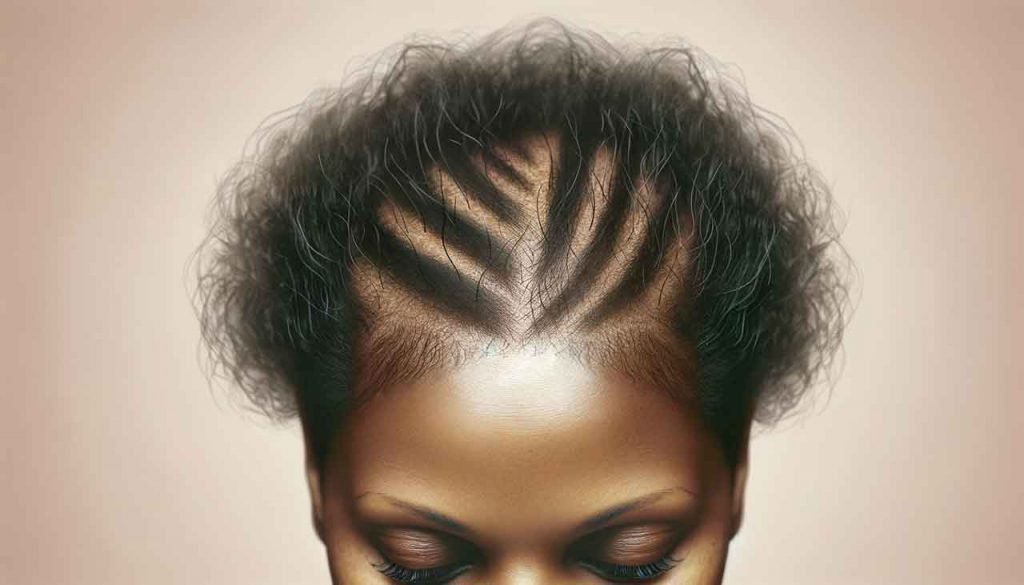
What are the Possible Treatments for Hair Loss in Women
So, you're dealing with hair loss and wondering what can be done. Let's explore the various treatments available, from understanding their efficacy to learning how lifestyle changes can help. We'll also look into new potential treatments like hair transplantation and how to stimulate hair growth, focusing on female pattern hair loss.
Insight into Hair Loss Treatment and Its Efficacy
There are several treatments you can consider if you're dealing with hair loss, but it's essential to remember that not all treatments will work for everyone. To treat hair loss effectively, you must understand the underlying cause and choose the treatment accordingly.
- FDA-approved treatments: The FDA has approved minoxidil and finasteride to treat female pattern hair loss.
- Lifestyle changes: A balanced diet and stress management can help stop hair loss.
- Natural remedies: Some herbs and supplements may help to prevent further hair loss.
- Medical procedures: Hair transplants and laser therapy can be considered in severe cases.
Understanding Treatments for Different Types of Hair Loss
Understanding your hair loss type is crucial, as it will guide your treatment choices. If you're dealing with hair loss in women, especially female pattern hair loss, you're not alone. Many women experience this, and understanding treatments for different types of hair loss can help you regain control. Seeking professional advice will help identify the symptoms and causes of your hair loss. There are various treatments, from topical applications like minoxidil to procedures like microneedling. Adjusting your diet and lifestyle can also prevent hair loss. Remember, everyone's journey is unique, and what works for one might not work for another. But with patience, perseverance, and the right treatment, you can navigate this journey alongside millions of women worldwide.
Role of Lifestyle Changes to Prevent and Treat Hair Loss
In your journey to combat hair loss, making certain lifestyle changes can significantly contribute to prevention and treatment. Hair loss in women, especially female pattern hair loss, can be alarming, but it's not a journey you must navigate alone. The role of lifestyle changes to prevent and treat hair loss is crucial and can involve:
- Healthy Diet: Eating foods rich in iron, protein, and vitamins can nourish your hair and promote growth.
- Regular Exercise: Physical activity can improve blood circulation, which is beneficial for hair follicles.
- Minimizing Stress: High-stress levels can contribute to hair loss. Implementing stress management techniques can help.
- Avoiding Heat and Chemicals: Excessive styling and chemical treatments can damage hair, leading to hair loss.
Unveiling the Potential of New Treatments like Hair Transplantation and Stimulating Hair Growth
While you're implementing these lifestyle changes, it's also worth exploring new potential treatments for hair loss, like hair transplantation and methods for stimulating hair growth. Hair transplantation is a procedure where hair follicles are moved from one part of your body to the balding area, providing a natural and lasting solution for hair loss in women. Meanwhile, treatments for stimulating hair growth aim to rejuvenate and strengthen your existing hair, combating female pattern hair loss. Such methods range from topical products to advanced light therapies. The potential of new treatments is vast, and we're here for you every step of the way. Remember, you're not alone in this journey, and together, we can help you regain your confidence and embrace your beauty.
Exploring the Effectiveness of Treatments for Treating Female Pattern Hair Loss
As you delve deeper into hair loss treatments, it's crucial to weigh the effectiveness of various options available for tackling female pattern hair loss. You're not alone in this journey; many women face the same challenges, and there's a community here for you.
Consider these four possible treatments:
- Topical Minoxidil: This over-the-counter medication can slow hair loss and stimulate hair growth.
- Oral medications: Prescription drugs like Spironolactone or Finasteride can help reduce hair loss.
- Laser therapy: This promotes hair growth by stimulating blood flow to the hair follicles.
- Hair transplant: This surgical procedure can replace lost hair.
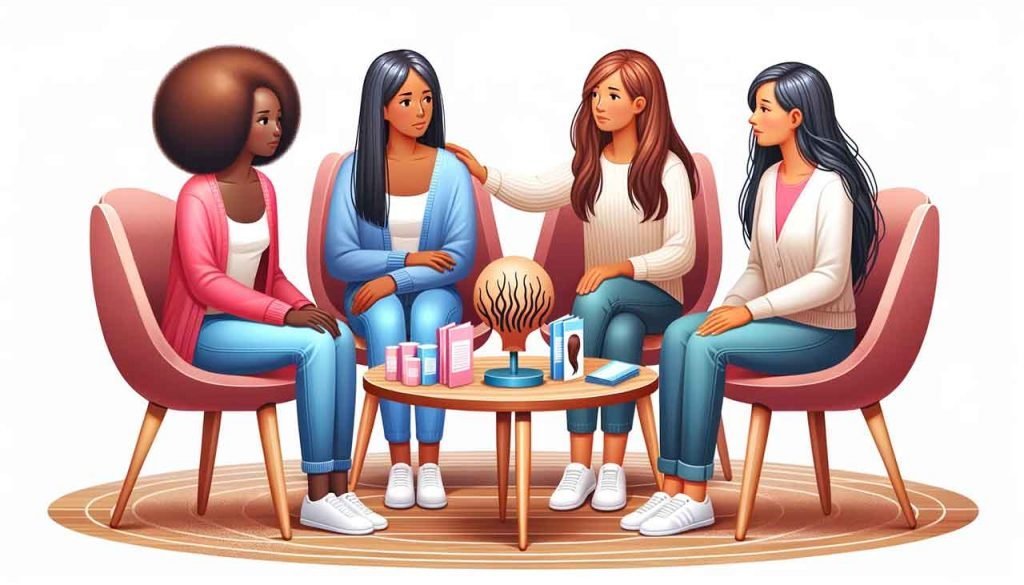
Frequently Asked Questions
What Common Misconceptions Exist About Hair Loss in Women?
You might think hair loss in women is rare, or it's just due to stress. That's not always true. It can be genetic, hormonal, or due to certain health conditions, and isn't always preventable.
How Does Pregnancy Affect Hair Growth and Loss in Women?
During pregnancy, you'll likely notice fuller hair due to high hormone levels slowing shedding. Postpartum hormone levels drop, and you might experience increased shedding, but it's usually temporary, and your hair should normalize.
Can Certain Hair Care Products or Routines Exacerbate Hair Loss in Women?
Yes, certain hair care products or routines can worsen hair loss. Overusing heat styling tools, tight hairstyles, and harsh chemicals can damage your hair, leading to breakage and potentially exacerbating hair loss.
Can Certain Hair Care Products or Routines Exacerbate Hair Loss in Women?
Yes, certain hair care products or routines can worsen hair loss. Overusing heat styling tools, tight hairstyles, and harsh chemicals can damage your hair, leading to breakage and potentially exacerbating hair loss.
Are There Any Lifestyle Changes That Women Can Make to Minimize Hair Loss?
You can make lifestyle changes to minimize hair loss. Eating a balanced diet, avoiding tight hairstyles, reducing stress, and avoiding heat styling tools can all help maintain your hair's health.
What Emotional or Psychological Impacts Can Hair Loss Have on Women, and How Are These Addressed?
You might feel stressed or embarrassed due to hair loss, which is normal. It's important to speak with a professional about these feelings. They can offer guidance and treatments to help you cope.
References:
Female pattern hair loss: A comprehensive review
Links:
Different Types of Alopecia: Exploring Various Forms of Hair Loss and Alopecia Areata
Female pattern hair loss: A clinical, pathophysiologic, and therapeutic review

